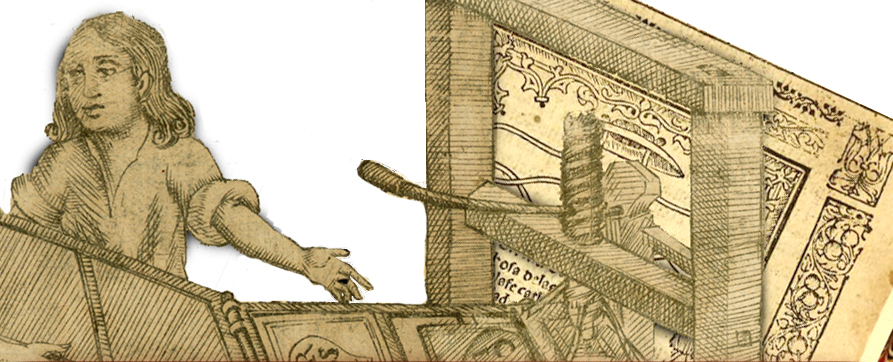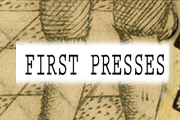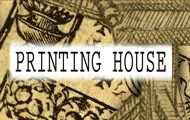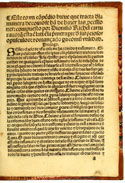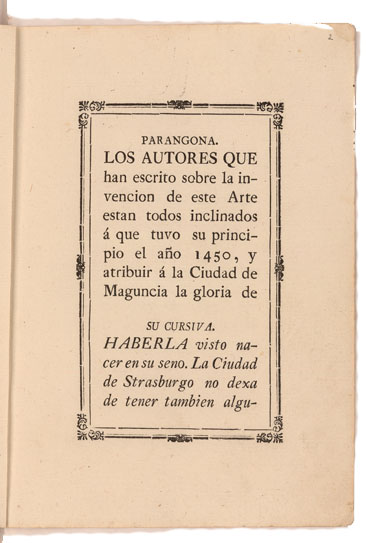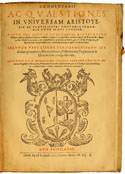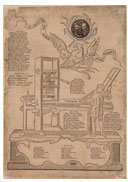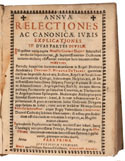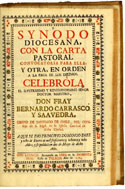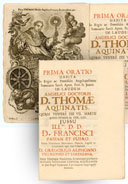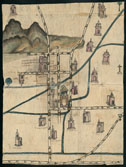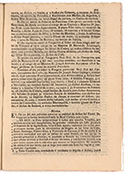| The raw materials necessary for the smooth operation of the press were largely imported prior to independence. While type cutters and founders were active in the seventeenth century, by and large, type was imported. Likewise with paper; although there was some local production in New Spain, there is no evidence that it was used in manuscripts or print. Even lamp black, the key ingredient for printer's ink, was imported, although there was certainly some local production. |
||
Early Typography 10. Denys le Chartreaux, Este es vn co[m]pe[n]dio breue que tracta d[e] la manera de como se ha[n] de hazer las p[ro]cessiones (Se imprimio en ... Tenuchtitlan Mexico: Por mandado del muy reuere[n]do señor don fray Jua[n] Çumarraga ... en casa de Juan Cromberger, 1544).Spanish printers were very conservative in their typography, retaining the use of gothic type long after Roman had been adopted elsewhere. Thus, of course, the Mexican branch of the Cromberger firm likewise employed gothic type in its earliest imprints. The first book printed in Roman type in Mexico was Alonso de la Veracruz's Recognitio summularum (Juan Pablos, 1554). |
||
Disappearance of Gothic Type 11. Catholic Church, Doctrina christiana, y catecismo para instruccion de los Indios (Impresso ... en la Ciudad de los Reyes: Por Antonio Ricardo primero impressor en estos reynos del Piru, 1584).The use of gothic type in Mexican imprints had almost entirely ceased by the time a printing press arrived in Lima, and none of the early Lima imprints used gothic type. |
||
| First Type Cutter and Founder in America 12. Alonso de Molina, Vocabulario en lengua castellana y mexicana (En Mexico: En casa de Antonio de Spinosa, 1571). Antonio de Espinosa went to New Spain at the request of Juan Pablos in 1550, to work for him as type cutter and founder. In 1558, he managed to break Pablos' monopoly and establish his own press. His second edition of Molina's Vocabulario (1571) is a tour de force, and an illustration of his vast typographical resources. Most folio volumes printed in Mexico were usually gathered in single sheets, but the 1571 Vocabulario, on the other hand, is a folio "in eights," that is four nested sheets per gathering. |
||
| 13. Matrices and sorts. Producing type entails carving the letterform in reverse on a metal punch, which is then used to strike a bronze matrix. Since this will slightly deform the metal, it must be "justified" before it can be used to produce type. A matrix is then fitted into a mold into which an amalgam of metals, largely lead, can be poured to produce uniform and identical pieces of type, known as sorts. Courtesy of the Providence Public Library. |
||
| Choices, choices 14. Muestras de los caractéres que tiene la imprenta que fué de don Manuel Antonio Valdés (En México: Año de 1814.) Printers produced type specimens--broadsides or pamphlets demonstrating the range of their typographical materials--from as early as the fifteenth century. This specimen from nineteenth-century Mexico is, apparently, unique. Only one surviving specimen from Latin America dates from an earlier year. |
||
| Printed Music 15. Juan Navarro, F. Ioannis Nauarro Gaditani, ordinis minorum regularis obseruanti[a]e: Prouinci[a]e apostolorum Petri, & Pauli Michhuacanensis. Liber in quo quatuor passiones Christi Domini... Nunc primùm magno studio, & ingenti labore in lucem editus (Mexici: Apud Didacum Lopez Daualos, 1604). Printed music appeared as early as 1554, and continued to be printed, in Mexico at least, through the early seventeenth century. After that point, it was either imported, or produced in manuscript. It only reappeared in Mexico in the eighteenth century, with the Regla de N. S. P. S. Francisco (José Bernardo de Hogal, 1728). |
||
| Two-Color Printing 16. Jerónimo Valera, Commentarii ac quaestiones in vniuersam Aristotelis ac subtilissimi doctoris Ihoannis Duns Scoti logicam (Limae: Apud Francisum à Canto, 1610). Printing in red and black, typically the title page only, but occasionally elsewhere, was common in the sixteenth and early seventeenth centuries. The red was achieved by adding vermillion to the varnish, rather than lamp black. The title page of Valera's Commentarii, here shown in facsimile, is the first such printing in South America. |
||
|
Patron Saint of Printing 17. Al Benjamin del Señor S. Juan Evangelista, (En Valencia: En la Imprenta de Monfort, año 1771).John the Evangelist is one of the patron saints of printers, the other being Saint Agustin. According to Tertullian, emperor Domitian ordered John to be boiled in oil before the Porta Latina in Rome. It is easy to understand his becoming patron of printers, considering that the fabrication of ink includes boiling lamp black with oil and rosin. While as early as the sixteenth century there was a religious brotherhood of printers dedicated to San Juan Evangelista in Madrid, there is no evidence of such a brotherhood in Latin America. Courtesy of the Providence Public Library. |
||
| 18. Miguel de Ibarra, Annuae relectiones ac canonicae iuris explicationes in duas partes divisae (Mexic[i]: apud Viduam Bernardi Calderon, in via Sancti Augustini, [1675]). Although requiring a second run through the press, two-color printing was not terribly difficult. Thus it is odd that it all but ceased by the second decade of the seventeenth century. Ibarra's Annuae is the only example I am aware of that appeared prior to the return of two-color printing in earnest in the 1680s. |
||
Beyond Two-Color Printing 19. Catholic Church, Synodo diocesana (En Lima: En la Oficina de la Calle de la Encarnacion, 1764). |
||
| 20. Gregorio Alfonso Villagómez y Lorenzana, Prima oratio habita in regio ac pontificio Angelopolitano seminario Sanct. Apost. Petri & Joann. in laudem angelici doctoris d. Thomae Aquinatis ([Puebla, Mexico: Reales y Pontificios Colegios de San Pedro y San Juan, 1770). On rare occasions, other inks or colorants might be used, such as blue or green, as in the Synodo diocesana or, gold leaf as in the Prima oratio. |
||
 |
Traces of Production 21. Gaspar de los Reyes, Sermon del gran privado de Christo el evangelista San Juan (Mexico: Por los Herederos de la Viuda de Bernardo Calderon, 1689). Ink was applied using horsehair filled leather balls to achieve a smooth and precise thickness. Here is an interesting example of bad inking revealing the edge of the ink ball due to uneven application of ink. |
|
| 22. Culhuacán (MEXICATZINGO). Mexico, 17 January 1580. This sixteenth-century map, taken from the Relación Geográfica of Culhuacán (Mexicatzingo), Mexico, shows a paper mill attached to the principle chapel of the cabecera, that of San Juan Evangelista. In addition, from the early seventeenth century, there was a hacienda known as the Rancho el Molino de Papel. Nevertheless, thus far there is no clear evidence that either produced much paper or if what they did manage to produce was ever used in books or manuscripts. Likewise, Spain's paper production could not meet demand. Thus both for Spain and Latin America, virtually all paper was imported, typically from Italy, but also from Lyon and the Low Countries. Courtesy of the Benson Latin American Collection at the University of Texas at Austin. |
||
| Sources of Paper 23. Francisco de Paula Sarmiento Fuentes, “Ynstrucciones para el bufete. Y mercancia arregladas á los comercios de la Europa” ([Mexico, 1781]). While paper was imported to Spain from many sources, Italy--and in particular, Genoa--was favored. This manuscript on commerce includes a guide to accounting practices, currency conversions, and the principle manufactures of various European cities. The entry for Genoa mentions the production of "papel florette y ordinario," and cites the royal ordinance that requires each balón be of 32 reams (later reduced to 24). What follows, however, is almost entirely in error. In reality, according to the Pragmática de tasas of 27 November 1680, each ream was to be composed of 20 manos, each mano of 5 cuadernillos (quires), and each quire of 5 sheets. |
||
Imports 24. Gazeta de Mexico (Mexico: Por D. Felipe de Zuñiga y Ontiveros, Calle del Espirítu Santo, 1784).This entry from the Gazeta de México of 8 September 1789 notes that on the 22nd of the pervious month the Frigate Nuestra Señora del Carmen arrived from Cádiz with 42 boxes of letters for the press, 167 balones of paper, and 9 boxes of books. |
||
| The Whole Package 25. Gazeta de Mexico (En Mexico: Doña María de Rivera. En el Empedradillo, February, 1733). This fascinating notice in the Gazeta de México of February 1733 announces the arrival of a new press and types to the office of María Candelaria de Rivera. In addition to listing the various sizes and kinds of type, including music, Greek, and Hebrew, it also includes a list of parts of the press and the workmen involved. Here we learn that the beater was responsible for making the ink, and of its composition. |
||
| Next | ||
| Exhibition prepared by Kenneth C. Ward. on view in the reading room from november 2014 to February 2015. |
||
